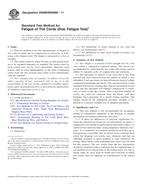Potřebujeme váš souhlas k využití jednotlivých dat, aby se vám mimo jiné mohly ukazovat informace týkající se vašich zájmů. Souhlas udělíte kliknutím na tlačítko „OK“.
ASTM F3015-13
Standard Test Method for Accelerated Laboratory Roadwheel Generation of Belt Separation in Radial Passenger Car and Light Truck Tires through Load Range E
Automaticky přeložený název:
Standardní zkušební metoda pro zrychlené laboratorní Roadwheel generace Belt separace v Radial osobního automobilu a Light Truck Tires prostřednictvím rozsahu zatížení E
NORMA vydána dne 15.11.2013
Informace o normě:
Označení normy: ASTM F3015-13
Poznámka: NEPLATNÁ
Datum vydání normy: 15.11.2013
Kód zboží: NS-54860
Počet stran: 7
Přibližná hmotnost: 21 g (0.05 liber)
Země: Americká technická norma
Kategorie: Technické normy ASTM
Kategorie - podobné normy:
Anotace textu normy ASTM F3015-13 :
Keywords:
accelerated laboratory aging, belt separation, oven, oven aging, roadwheel, tire, ICS Number Code 83.160.01 (Tyres in general)
Doplňující informace
| Significance and Use | ||||||||||||||||||
|
4.1 Belt edge separation is a tire condition that can be encountered in tire use, particularly in high tire temperature environments. 4.2 The goal of this standard is to define a scientifically valid protocol for the laboratory generation of belt edge separation in a tire that has previously completed accelerated laboratory aging as described in Practice F2838. This test method does not establish performance limits or tolerances for tire specifications. 4.3 However, as stated in the scope, some tires may not develop belt edge separations under the specified test conditions. They may develop other EOT conditions that are not due to belt edge separation. Also, some tires may not develop any EOT conditions during the course of the test prior to a DCT. |
||||||||||||||||||
| 1. Scope | ||||||||||||||||||
|
1.1 This standard describes a laboratory method to evaluate tires for their tendency to develop belt edge separation, via the use of a standard roadwheel (Practice F551/F551M). This evaluation is conducted on tires that have undergone accelerated laboratory aging as described in Practice F2838. 1.2 The End-of-Test (EOT) conditions that can be produced by this method include target (belt-edge separation), non-target (conditions other than belt-related separations that can be developed in passenger and light truck tires through on-road use), and non-representative (conditions that are typically developed only on laboratory roadwheels). There is also the possibility that no visible EOT conditions may be generated during the course of this test. In this instance the user may choose to select a designated completion time (DCT) as the EOT condition. 1.3 The values stated in SI units are to be regarded as the standard. The values given in the data log in 1.4 This standard does not purport to address all of the safety concerns, if any, associated with its use. It is the responsibility of the user of this standard to establish appropriate safety and health practices and determine the applicability of regulatory limitations prior to use. For specific precautionary statements, see Section 6. |
||||||||||||||||||
| 2. Referenced Documents | ||||||||||||||||||
|
Podobné normy:
Historická
1.1.2013
Historická
1.1.2011
Historická
1.2.2013
Historická
1.6.2012
Historická
15.5.2014
Historická
1.1.2011
Doporučujeme:
Aktualizace technických norem
Chcete mít jistotu, že používáte pouze platné technické normy?
Nabízíme Vám řešení, které Vám zajistí měsíční přehled o aktuálnosti norem, které používáte.
Chcete vědět více informací? Podívejte se na tuto stránku.



 ASTM D6477-13
ASTM D6477-13 ASTM D6588/D6588M-11..
ASTM D6588/D6588M-11.. ASTM D6700-01(2013)..
ASTM D6700-01(2013).. ASTM D7760-12
ASTM D7760-12 ASTM D885/D885M-10a(..
ASTM D885/D885M-10a(.. ASTM E1859/E1859M-11..
ASTM E1859/E1859M-11..
 Cookies
Cookies
